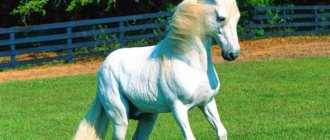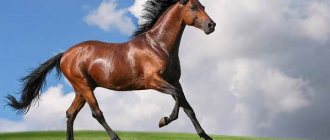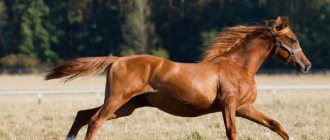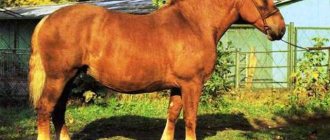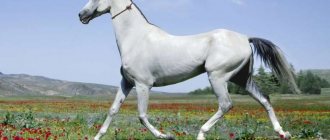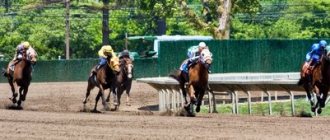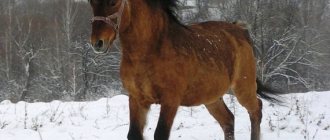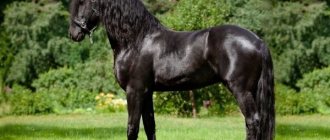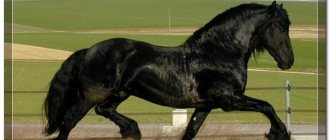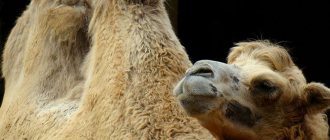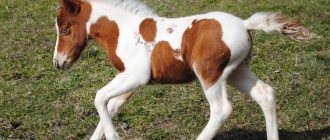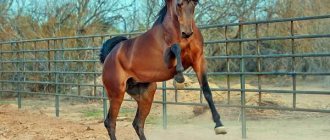Well, the mustang is the feral domestic horse of North America. The most famous mustang is, of course, Spirit. Mustangs are small in stature, usually overgrown with hair, but ideally adapted to their living conditions. Overall, this is a very impressive horse.
The Mustang is a horse with a relatively long history, dating back to the 16th century. These creatures are descendants of domesticated animals that were brought to America by Europeans during the period of active exploration of the new continent. The name of the breed, which has become recognizable throughout the world, comes from the Spanish word “mestengo”, which translates as “wild”, “stray”, “nobody’s”.
How herd animals behave
Horses are social mammals.
In wild or semi-wild populations, they form herds with a social hierarchy. The herd includes up to 26 mares, 5 stallions and young animals of various ages. Horse herds have a well-functioning social hierarchy, dominated by alpha males. They spend most of their time defending the group from predators and from competing males. Horses are active at different times of the day, depending on the season. In hot weather, they graze in the morning or evening, avoiding high midday temperatures. Horses sleep segmentally during the day, sleep lasting no more than 2 hours. Animals do not lie on the ground for more than an hour and sleep standing up.
Herd of horses
How do they communicate with each other?
Horses have whiskers on their nostrils and cheeks that are used to sense the environment through touch. Vision is the primary means of obtaining information. The ears are long and straight, which aids auditory perception
Although the sense of smell is important, it is not a primary organ and plays a lesser role than vision or the sensory receptors in the nostrils or cheeks.
Horses communicate with each other through gestures and vocalizations. Members of the herd neigh, bite, push and kick each other to establish or reinforce a hierarchical structure and to express dominance.
Interesting facts about mustangs
The Mustang is an animal with numerous features that cannot be discussed in one short article. Here are some of the interesting facts, in addition to those described above:
• If previously there were about 2 million heads, then after people mercilessly hunted horses for meat and skins, their number has greatly decreased and is approximately 20 thousand.
• There is a coin in Nevada with the image of a mustang (denomination of 25 cents).
• The US government has taken mustangs under legislative protection.
• A mustang mare usually separates from her herd a few days before giving birth and seeks temporary shelter. The newborn baby begins to walk within a few hours after birth, and after a few days they return to the herd together.
Origin story
Mustang horses are a wild species and their fate is quite difficult. It is believed that they originated on the North American continent, although many millennia ago all the horses on it disappeared as a species, that is, they became extinct. In the 18th century, after the conquest of America by the Spanish conquistadors, imported horses appeared there again. The aborigines did not want to use animals other than for food, which is what they did with the mustangs that came to them
Only the example of the Spaniards convinced the Indian population to pay attention to the useful qualities of horses - as a means of transportation, in battles and in hunting animals.
The Indians rode horses completely differently from the Spaniards; they did not need a saddle, they used a loop instead of a bit, which they did not even pull, preferring to control the horse with their voice. Of course, horses spread very quickly after that throughout the mainland. Mustangs were often left to fend for themselves after being wounded, lame, tired, used as consumables, and they eventually fought off people.
It did not take too long for the prairies to be filled with herds of wild mustangs. They developed quickly, their numbers grew, since there were simply no predators there.
As a result, by the middle of the 19th century, approximately two million free horses were galloping across the prairies. Their ancestors have Andalusian and Arab roots, but constant crossing, including with not very purebred representatives, has modified the mustangs over time. Moreover, free life on the prairie did not require a spectacular exterior, but endurance, speed, strength, and good health were vitally important.
Enemies
The most dangerous predators for mustangs include the wolf and the puma. These animals are big enough to kill a horse. Most often they attack foals, old and sick individuals, thereby freeing the herds from the weakest representatives. Coyotes and foxes pose less of a threat to these creatures. These predatory animals attack only recently born foals left without the care of their mothers.
However, the most formidable enemy of mustangs is people. Hunting for these ungulates was widespread in the 19th and early 20th centuries, which almost led to the complete extinction of the population. Now this type of horse is protected by law.
Horse breeding
Mares and stallions are ready for mating porn from the age of three. The male can cover the female all year round, but is most active in the spring and first half of summer. The female's fertility depends on estrus. It occurs monthly and lasts from 3 days to a week. Estrus begins with slight bleeding. Ovulation occurs at the end of this period, the egg is capable of fertilization within 48 hours. During estrus, the mare becomes submissive, neighs and snorts specifically, calling stallions to her. Outside of heat, she does not allow males to approach her.
In the wild, horses mate from March to mid-July. The appearance of the brood in this case will occur in the spring or end of winter, when there is more food. During this time, one stallion is able to cover up to fifty mares. They allow males to approach them from the age of 2, but are fertilized and bear foals only a year later. Only the best stallion enters into intercourse, thus maintaining a good gene pool in the herd.
Breeding of domestic horses can occur in different ways, depending on the type of keeping. A neighing mare in heat and a breeding stallion or several females and one male are selected. There are the following types of mating in public:
- Mating in herds, as in the wild.
- The manual method in a paddock, when a person fully controls the process, and the mare can be hobbled.
- Cooking method. 5-6 mares and one stallion are released into the pen for 4-5 days. If a male consistently chooses only one female, she will be removed from the pen more quickly.
- The tricky way. The same as the cooking one, only all the mares remain in the pen until the end.
- Artificial insemination by specialists in this area
Only the best stallions are selected for breeding work. The rest undergo castration. It is recommended to castrate draft horses as well, leaving only the best for breeding. A gelding works much better than a stallion: he has a calm character, all his strength goes towards completing the tasks set by the person. It is best to crossbreed and breed horses at breeding farms, where there is certification and registration, microchipping, branding of young animals is carried out, and a passport is issued.
The mare's pregnancy lasts 11 months (from 320 to 355 days). Childbirth or foaling lasts 2-4 hours, complications are extremely rare. The female gives birth to one foal weighing 25-30 kg, almost immediately gets to her feet, then the afterbirth is released, complete involution of the uterus after birth occurs almost two weeks later. Already in the last days of pregnancy, the mare begins to secrete colostrum. Lactation lasts 9 months if the female is milked. Feeding foals with milk takes 3-4 weeks, after which they begin to introduce complementary foods in order to quickly switch to regular feed. The foal grows quickly and remains with its mother for 6-7 months.
Reproduction
The mating season for mustangs begins in April and lasts until the end of July. Males enter into serious fights with each other for the right to take possession of the best females. The strongest wins. Thanks to this, healthy and strong offspring are born. Pregnancy in horses lasts 11 months. Each mare gives birth to one foal. Before the onset of winter he will have time to get stronger.
During the birth, the mare goes to a safe place and takes care of the baby. Within two days, mother and foal join their herd. The female feeds the offspring with milk for 6–8 months. Males live with their parents, and at the age of three they leave them and remain alone, gaining experience. And then they create their own group of horses or win back a herd from old stallions.
Despite the government ban, the capture of mustangs continues. Some people tame wild horses and sell them for a lot of money, because having such a horse is very prestigious. Horses are used in some types of equestrian sports. Their main advantage is unpretentiousness and endurance.
Mustang (horse): reproduction
There are real legends about the spirit and character of the Kiger Mustang horse. Most of the information in them, of course, is exaggerated, since they describe an animal with a rabid character that cannot be controlled.
This is an ideal horse for riding - very fast and durable. This feature is associated with the development of the breed, because in the wild the animals had to constantly get their own food and move around a lot, which made them so strong.
This breed is not common in Russia, but in the USA the average price of a Kiger Mustang is 1.5-3 thousand dollars, which in our money is approximately 85-170 thousand rubles for an adult animal.
The cost is justified by the rarity of the breed and the small number, because in total there are no more than 60 thousand kiger mustangs left, and even fewer tamed individuals.
Mustangs are strong animals; the blood of Indian ponies, Spanish, French, and German horses flows in their veins. As a result of this, their color is very diverse. The most common colors are red, piebald and bay. There is also a dun, palomino, appaloosa mustang (horse), the photo confirms this wonderful variety of colors.
So we can say that these beauties can look very interesting in appearance, not like ordinary horses. I would also like to note one color, this is a black mustang, a horse with this color reflects all the wild beauty of animals of this species. It was once brought to Mexico and Florida, and traces its roots back to Iberian ancestors.
The mating season for mustangs lasts from April to July. For the right to mate with the chosen one, young males fight fiercely among themselves, as is customary in the wild - the strongest wins!
Females carry foals for 11 months; when the pregnant mare feels that it is time to give birth, she leaves the herd for a quiet, safe place. In such a natural “maternity hospital” a small mustang is born. It is very rare that two babies are born at once; usually a female mustang becomes the mother of only one foal.
A female mustang feeds her cubs with milk for seven to eight months. After this time, the foals grow noticeably, their legs become strong and strong. Until the age of three, young people live in a herd with their mothers, but after three years, the leader male drives the stronger young males out of the family, thereby preventing competition. Sometimes the mother leaves with the mature foal, but in most cases the female remains with her herd.
In the 1800s, California was hit by a severe drought during which farmers considered it unacceptable to keep mustangs. As a result, they killed 40,000 wild horses.
In the 1920s, mustang meat was added to pet and chicken feed. As a result, about thirty million pounds of horse meat were canned.
In 1971, the US Congress designated the Mustang as a living symbol of the historical and pioneering spirit of the West.
In 1971, a law was passed that makes it illegal to harm, capture or kill mustangs roaming freely on public lands.
Mustangs are considered very resilient and hardy; they can cover up to eighty kilometers in one day.
These free and beautiful animals can be of different colors: there are bay, red, and piebald mustang horses. The weight of an adult individual fluctuates around 500 kilograms, the height at the withers (height) is approximately one and a half meters. The Mustang horse breed is characterized by endurance, remarkable strength, unbridled law, the presence of intelligence, the instinct of self-preservation, and adherence to herd rules of life.
Photo of a bay mustang
Mustang: description
The name of the horse comes from the Spanish dialect, which means “wild livestock.” Quite often, wild horses are classified as a particular breed, although they lack the distinct qualities that are characteristic of breeding work. Therefore, these are simply wild horses that have no breed qualities.
Mustang horse breed features | Horse breeding | Mustang breed horses
Appearance
It is believed that the progenitors of the mustang are horses of the Andalusian (Liberian) breed, which partially escaped or were released into the pampas in 1537 by the Spaniards who left the colony of Buenos Aires. The presence of comfortable natural conditions contributed to the rapid reproduction of horses, as well as their adaptation to the conditions of the natural environment. Despite this fact, the legendary mustangs received the status of world-famous wild horses after their blood was mixed with the blood of Andalusian horses, as well as some European horse breeds.
Spontaneous crossing
The beauty and strength of mustangs became known after they contained a whole cocktail of genes, both wild horses and French and Spanish thoroughbreds, Dutch draft horses and even ponies.
Interesting to know! Mustangs are characterized by the fact that they are dominated by genes from French and Spanish breeds, since in the 16th and 17th centuries Spain and France explored the North American continent more actively than Great Britain.
Spontaneous mating of breeds and species was carried out on the basis of natural selection, when the genes of decorative or unproductive breeds were lost due to their uselessness. Preference was given to the qualities of riding horses, which could easily evade pursuit. As a result, the Mustangs received a light frame, allowing them to develop considerable speed.
Exterior
Depending on living conditions, mustang populations differ from each other in their external characteristics. In addition, even within a single population there are certain differences between animals. If we talk about the general appearance of mustangs, then these animals resemble riding horses, with denser bone tissue when compared with domestic breeds. Mustangs are not the sleek, tall horses they are shown in movies. Their height rarely exceeds one and a half meters, with a weight of no more than four hundred kilograms.
Interesting moment! According to eyewitnesses, the body of the mustangs shines as if it had been washed quite recently with a brush and shampoo. Such purity testifies to the innate cleanliness of the species.
Mustangs are distinguished by the fact that they have powerful legs, which allows them to withstand long treks. Hooves that do not know what horseshoes are are able to withstand the influence of any natural surface, and for a long time. These animals are characterized by phenomenal endurance, as well as speed, which is achieved thanks to the unique constitution of the body.
Suits
Most mustangs are colored reddish-brown with a rainbow tint, while the rest are bay, piebald, gray or white. Black mustangs are considered the most beautiful, although this color is extremely rare. The Indians had a special attitude towards mustangs. At first they used their meat to feed themselves, and then they caught these animals to ride on them and also to transport their property. As a result of the domestication of mustangs, the animals constantly improved in terms of their characteristics.
Interesting to know! White or white-spotted mustangs were especially respected and loved by the Indians, especially if their spots were located on the forehead or chest. The Indians considered such horses sacred, capable of protecting them in battles.
Pure white mustangs enjoyed no less respect and love among the Indians, as they were considered almost mythical creatures possessing immortality. They called white mustangs ghosts of the prairies and plains, as well as their spirits.
Character and lifestyle
Mustangs are still considered the subject of various fictions. It is believed that they unite in numerous herds numbering hundreds of individuals, but in fact, each herd contains a little more than two dozen animals.
Life in freedom
Mustangs differ from domestic horses in that they are accustomed to living freely in the open air, without contact with humans. Mustangs are strong, hardy, unpretentious animals with strong innate immunity. The life of mustangs is that every day they do what they do: calmly nibble grass or look for new territories rich in food. They are able to survive for several days without food or water.
Important point! Naturally, the winter period is the most difficult time of the year, since the food supply is significantly depleted, and the ambient temperature forces animals to huddle together to keep warm. During this period, especially weakened or sick horses become easy prey for various predators.
Despite the fact that their coat is characterized by shine, mustangs love to take mud baths. Naturally, they not only love mud baths: they simply need to take them in order to get rid of various types of parasites. To do this, the animals just need to find a puddle of suitable size. Modern mustangs live in the same small herds as their ancestors. Each herd controls a certain territory, which is guarded in order to prevent strangers from entering it.
Hierarchy
At the head of each herd of mustangs there is a strong male and female, who control the herd, depending on the current situation. The male makes sure to organize a timely defense in the event of an attack by predators, and also leads his herd in a direction that provides the herd with food. An alpha male can cover any mare in his herd. He regularly has to prove his superiority over other males by engaging in fights. If adult males fail to defeat the alpha male, then they unquestioningly obey him. The leader has to make sure that the females do not lag behind the group, since they may be covered by some outside stallion. Stallions often leave their droppings on someone else's territory, so the leader has to place his own pile of droppings on top of this pile, thus announcing his presence in the territory.
The alpha male's girlfriend watches over the herd when the male has no time. As a rule, this happens when the leader sorts things out with other males, and also when the leader needs to protect his family from outside attacks. The mare receives this status not because she is stronger than other females or smarter than them, but because she is the most fertile. Not only females, but also males obey her. If we talk about the leader, then he simply must have unique experience and memory in order to lead his family to watering holes and territories rich in food. As a rule, young stallions cannot cope with such responsibilities.
How long does a mustang live?
Living in the wild, mustangs live on average about three decades. Legend has it that mustangs can give their lives for their freedom. Only an experienced horse breeder can tame these horses. If you manage to do this, the horse becomes devoted to the person for life.
Where does it live?
Nowadays, mustangs can be found in the steppes of South America, as well as on the prairies of North America. Experts believe that wild horses lived in America before, but for unknown reasons they became extinct approximately 10 thousand years ago. A new population of wild horses in America appeared as a result of active human development of these territories. The Spaniards preferred to tease the Indians by appearing in front of them on Iberian stallions, since they considered the riders on horses to be deities.
The development of new territories did not go smoothly, as the local population resisted the colonization processes. As a result of armed skirmishes, the horses were left without riders and fled into the steppe. These horses were joined by individuals who managed to escape from pastures or night bivouacs. This is how herds of animals were formed and began to reproduce. As a result, wild horse populations increased at a rapid rate over a vast area from Paraguay in the south to Canada in the north. Nowadays, if we talk about the United States, mustangs are found on the pastures of states such as Idaho and California, Nevada and Utah, North Dakota and Wyoming, as well as in the territories of Oregon, Arizona and New Mexico. Wild horses are also found on the Atlantic coast, as well as on the Sable and Kimberland Islands.
Important point! Mustangs based on horse breeds such as the Andalusian and Sorraia are found in Spain. On Vodny Island, in the Rostov region, lives a separate population of Don mustangs.
American Mustangs.
What does a mustang eat?
Wild horses, oddly enough, cannot be considered completely herbivores. If there is a lack of food, they can switch to eating animal food. Every day, adults eat about two and a half kilograms of plant food.
The main diet of mustangs consists of:
- From forbs and hay.
- From leaves and branches.
- From young shoots of various vegetation.
- From shrubby vegetation.
- From tree bark.
Several centuries ago. When people were not so actively exploring new territories, mustangs felt very comfortable in the vastness of the prairies and pampas. Nowadays, mustangs have to be content with territories where there is very sparse vegetation, since the lands are not characterized by high fertility, and there are also few natural bodies of water left.
Important information! In summer, a mustang needs to drink up to 60 liters of water every day, and in winter, half that amount. Typically, wild horses visit natural water sources twice a day. To replenish their body with minerals, they visit salt licks.
To find food for themselves, the herd sometimes has to travel hundreds of kilometers. In winter, wild horses use their hooves to extract vegetation from under the snow, and use the snow to replenish their body with fluid.
Reproduction and offspring
The breeding season for mustangs begins in spring and ends in early summer. Females attract suitors by waving their tails in front of them. To get closer to one of the mares, the stallions have to engage in fights. The one who wins and gets the right to impregnate the female. As a result of only the strongest males mating, the gene pool of wild horses is constantly improving.
The female carries her future foal for 11 months. If twins are born, then this is a deviation from the norm. Before giving birth, the female leaves her herd to find a suitable place to give birth. The offspring appears in the spring, and after just a couple of hours the foal gets to its feet and can even run. On the second day after birth, the foal returns to its herd with its mother.
The mother feeds her baby with milk for one year until a new offspring is born. The female immediately after giving birth is ready for the next mating with males. After living in the world for six months, the offspring begins to try adult food. The offspring behave quite actively, and by playing, they train themselves, since they have a difficult life ahead, where strength and dexterity will not hinder them.
Interesting fact! The alpha male gets rid of his growing competitors as soon as they reach three years of age. The mother can stay with her herd or follow her son.
Young males will begin the breeding process in another three years. To do this, they need to form their own harems, and some take part of the harem from their leader.
Natural enemies
Man hunts mustangs to get meat and leather, and therefore is considered the most dangerous natural enemy. Nowadays, the meat of these animals is used to produce pet food. Mustangs have high speed as well as endurance, which allows them to escape from various predators. Unfortunately, not all types of predators manage to escape mustangs, especially if you take weak or sick individuals.
Dangerous enemies for mustangs are:
- Cougars.
- The Bears.
- Wolves.
- Coyotes.
- Lynxes.
Mustangs have their own proven method of defense against various predators. They line up so that the females with their offspring are in the center. And along the perimeter the males line up, with their backs turned towards the predators. They defend themselves with the help of their strong hind legs, armed with powerful hooves. Not every predator is able to withstand such a blow without negative consequences for its health.
Polish Konik
This wild horse comes from Poland, which is reflected in its name. It is believed that the ancestor of the Polish Konik is the Tarpan. Accordingly, the horse is medium-sized, proportionally built and has strong limbs. But more about the appearance a little later. Polish konik was used as labor. Breeders, trying to improve the breed, infused Arab blood.
The Polish Konik is slightly taller than a pony. Its height at the withers is on average 140 cm. An adult weighs about 370 kg. Maximum weight - 405 kg. As for the breed standard, the animals have small and neat ears on their heads. Beautiful, medium-sized eyes set wide on the muzzle. The neck, like that of the tarpan, is short, but muscular. The withers are quite low and the shoulders are straight.
The Polish Konik is a muscular and strong animal. He has strong legs, which are not parallel to each other, but are shaped like a saber. The color is mousey. Gray and brown shades predominate. Sometimes there is a bluish tint, which gives the horse a piquancy. According to the breed standard, there should be no white markings on the horse’s body, but their presence is not a violation. Some representatives of this breed become white in winter.
Features of keeping at home
Wild horses of this breed are unpretentious. If we talk about those individuals that have been tamed, then you won’t have to build a stable to keep them. The only exceptions are those regions of Russia in which the climate in winter is too harsh. Like the Camargue, Polish Koniks are long-lived. They boast good health and fertility, which facilitates the conservation of the breed at the present time.
The flexible character and calm disposition make it possible to keep the Polish Konik in captivity. In addition, it is worth noting that among all other breeds, the Polish Konik is the most manageable. It can be kept as a child's companion and used for riding.
Appearance
Judging by photographs and films, mustangs appear to us to be quite large horses. But that's not true.
- The length of the horse is no more than 1.5 meters.
- Weight from 320 to 400 kg.
- Height at withers – up to 1.5 m.
Due to the mixture of different species of equids of all colors, you can find different colors among mustangs: piebald (with spots) and bay, red, black, appaloosa (white color with dark spots).
Interesting! The mustang's back and neck are short, with weakly defined withers. This combination of qualities allows mustangs to develop greater speed.
Mustangs are distinguished from all other breeds by their short body and strong legs. Their mane is long, silky, shiny, their body is clean, as if an invisible groom is constantly looking after the horses
Origin
Once upon a time, horses called mustangs were common working horses for the Spaniards. Many of them escaped into the wild, fought off people, ran away from pastures, some lost their owner in battle and over the centuries mixed with other breeds. Their appearance and character changed, and soon from obedient workers, not murmuring animals, they turned into wild, strong, free and unbridled horses. And steel is called "feral domestic horses" from the Spanish word "mestengo".
Wild mustangs
Mustang horses were found in large numbers in South America, Argentina and Paraguay. By 1600, the mustang horse breed had multiplied en masse in the Strait of Magellan. Life in freedom also affected his appearance: his head grew larger, his ears became longer, his fur became longer and thicker. At the beginning of the 20th century, the population increased and reached a number of about 2 million. Today, due to the rapid hunting of this species (they are hunted for their skin and meat, which are highly valued in that region), they are almost exterminated, their number is no more than 20 thousand heads.
Key Features
Mustangs are distinguished from all other breeds by their short body and strong legs. Their mane is long, silky, shiny, their body is clean, as if an invisible groom is constantly looking after the horses.
When the female leads the herd away from danger, all the mustangs obey her. The dominance of the female is determined by fertility, and the mares never conflict. If danger is close, the herd stops and regroups into a square figure: the males remain outside and turn their muzzle towards the center, with their croup outward. There are females and foals standing inside.
Interesting! Mustangs love to play and frolic in the wild. Horses (you will see the video at the end of the article) run around with their heads thrown back, neighing and having fun. This is freedom!
The mustang is a herbivore. In the wild, it eats grasses, small shrubs, and leaves. There is not always enough vegetation on the prairies. Horses sometimes travel up to hundreds of kilometers in search of food.
Horse care
Keeping horses at home is a very responsible task, because they need to be provided with regular food, walking, and take care of the improvement of the stable. In general, proper care of a horse is the key to a long and fulfilling life.
There are the following basic rules regarding the care and maintenance of horses:
- The horse needs to be fed 3-4 times a day. If, during free grazing, she finds her own food, then when she is in the stable, the owner must take care of providing her with hay or grass. Also, vitamin and mineral supplements must be present in the horse’s diet. But it is not recommended to suddenly change the horse’s diet; it has a delicate digestive system.
- In addition to food, you need to take care of drinking. So the horse should always have drinking water at room temperature at his disposal.
- During the hot season, it is necessary to regularly clean and bathe the horse (it is advisable to do this daily). In cold weather, it will be enough to simply clean the horse with a scraper. You need to take special care of the tail and mane.
- The stable where the horse lives must be regularly ventilated and also heated in winter. And, of course, it must be cleaned daily.
- The horse must be walked regularly, as prolonged stay in a cramped stable can have a negative impact on its musculoskeletal system.
What does a mustang eat?
The grasses that grow on the vast American prairies are poor in nutrients, so mustangs have to constantly migrate to have enough food. In terms of nutrition, these wild horses are unpretentious. In the spring, mustangs consume green herbaceous plants and flowers. During this period, adults can consume up to 6 kg of vegetation per day.
Later, when the plants dry out due to high temperatures, the horses continue to eat them. The dry season is the least favorable period for these wild animals. There is almost no dry grass left, and the horses are forced to eat:
- branches;
- moss;
- lichen;
- berries;
- bush leaves.
In regions where snow falls in winter, horses have adapted to clear it with their hooves to obtain the scant remains of vegetation. These wild horses often experience severe salt deficiency. To replenish it, they can gnaw bones, which are often found on the prairie. In addition, they often eat clay to obtain essential minerals. In the hottest months, horses go to water 2 times a day, consuming up to 50-60 liters of water. In cool weather, 30-35 liters of liquid per day is enough for them.
Mustang horse: history and lifestyle
Many species of domestic animals have feral populations that live completely apart from humans. But none of them managed to earn the fame enjoyed by wild horses - mustangs. In better times, millions of these animals roamed the steppes and pampas of North and South America, firmly becoming part of the culture of the American peoples.
Habitat
Wild mustangs live on the American prairies - from Mexico to Texas.
Some mustangs are still used by Indians as a means of transportation. Due to their incredible endurance, they are able to overcome enormous distances.
Tamed, that is, broken horses today exist in both America and Europe.
Interesting! "Mustang" in Spanish (mesteno) means "not owned by anyone" or "wild". This translation explains the freedom-loving nature of this proud animal.
The main male leader in the herd (he is at least 6 years old), the alpha female, other females and young animals
Subspecies
Today, several isolated groups of mustangs live in the western United States. The absence of genetic contacts influences the formation of pronounced differences. Common characteristics of groups allow us to determine the main ancestor.
Thus, in the state of Idaho, the herds are endowed with the characteristics of two elite breeds - the Thoroughbred Saddlebred and the American Saddlebred. Several groups in Nevada have clear characteristics of the appearance and conformation of the American Curly Bashkir breed. In Wyoming, there are herds with distinct features of American Saddlebreds.
Watch this video on YouTube
Genetic studies have made it possible to identify significant “Spanish ancestry” (ancestor - Andalusian horse) in a number of groups. These include the Cerbat Mustang from Arizona and the Priory Mountain Mustang from Montana and Wyoming.
As already indicated above, the stallions in question are distinguished by a wide variety. They are actively used in breeding to produce new horse breeds. Mustang genes are present in many modern American horse breeds.
Among the individual breeds of mustangs, one can distinguish the Kiger-Mustangs. This is an independent breed, which is distinguished by its gray-brown color with a reddish tint. The mane is black or dark brown.
They may have “zebra stripes” (transverse stripes on the legs) and “belt” (a clear black-brown stripe along the ridge). They are distinguished by endurance, activity and intelligence. Actively used for horse riding.
In modern horse breeding, an independent breed also stands out - the Spanish mustang. The ancestors of the breed are individuals of the Colonial Spanish Horse - a general designation for stallions and mares brought by the Spaniards to America during colonization.
The Colonial Spanish horse has genes predominantly from the Andalusian and Berber breeds. The variety was formed in the mid-20th century thanks to a selection of individuals with pronounced “Spanish blood” from groups of wild horses.
Signs of Spanish Mustangs:
- height - 137-152 cm, individuals above 152 cm are discarded from the breed;
- weight - from 290 to 500 kg;
- physique - slender, muscular, harmonious;
- noble head with a wide forehead, small muzzle and straight profile;
- neck curved, medium length;
- short back;
- rounded croup with low-set tail;
- legs straight;
- the hooves are round and dense;
- wild colors predominate.
A distinctive feature of Spanish mustangs is their extreme endurance. With a rider, they can cover considerable distances.
The breed is popular among lovers of horse riding and horseback riding along long routes. “The Spaniard” is involved in international horse riding competitions.
Spanish mustangs
These animals were widespread in Spain even before the discovery of America. Now this species is on the verge of extinction. Spanish mustangs have a lot of differences from American ones. The wild horse found in Spain is descended from the Sorraia and Andalusian breeds. Spanish mustangs are distinguished by their endurance and unusual beauty. They are relatively small. At the withers they reach only 110-120 cm.
There are horses of different colors, but the most common are black and chestnut. The animals' fur is short and silky. Most individuals have a thick mane and tail. These horses can run up to 250 miles with good performance, for which they are highly valued by equestrian sports enthusiasts.
The endurance of these horses is determined by developed muscles, large lung capacity and a well-functioning cardiovascular system. Animals are unpretentious in terms of nutrition. Since the breed developed in natural conditions, it is resistant to many infectious diseases of horses. Spanish mustangs are now used by some stud farms to improve existing riding breeds.
Difference from domestic horses
The mustang breed was formed spontaneously, and therefore is of great interest to breeders. Migrating, herds of feral horses of Spanish and French purebred breeds crossed with horses of local breeds, even with draft horses and ponies. Natural selection made its adjustments. Horses of the riding type turned out to be the most adapted to the new living conditions, since their high speed allowed them to run away from enemies. It is clear that the heavyweights also made their contribution, because wild horses are hardy and strong.
Advantages of Mustangs:
- high speed;
- force;
- unpretentiousness;
- immunity to diseases.
Disadvantages include excessive love of freedom. Even a well-trained mustang will not allow every rider to mount it. But when an animal recognizes its owner, it will be very devoted to him.
Mustangs were popular among the Indians. At first they hunted wild horses for meat, and then they began to tame and train them as riding horses. Horses with light spots on the chest and head were most valued. These were signs of the sacredness of the animal. The Indians believed that the owner of such a horse would be invulnerable in battle.
White horses were also deified. According to Comanche beliefs, they were immortal and had mythical powers. It should be noted here that the North American Indians had a cult of the color white, and they called white horses plain ghosts and prairie spirits.
Black horse
Mustangs can also be black. A beautiful horse is a black horse, which is always in price. Typically, this suit is preferred by people who are purposeful and powerful by nature. This horse has a black color with a bluish tint.
It is believed that the horse of A. Macedonian is a representative of this particular suit. This black horse combined a beautiful and powerful physique, a royal appearance and a formidable character.
Mustangs have only four basic colors: gray, bay, black and red. Other types arose from the black color, for example, smoky black.
Nutrition and reproduction
Like other horses, mustangs are herbivores. They feed on fresh grass, small shrubs and leaves from trees. Animals can travel very long distances to find food.
Horses that have been tamed eat about three kilograms of feed per day at home. This could be feed, hay or fresh grass. These wild animals also love to eat carrots and sugar. When it is very hot outside, they need about sixty liters of water per day, but if the weather is not hot, then half as much - thirty liters.
Reproduction
Mating games in horses begin in mid-spring and continue until early summer, this contributes to future reproduction. In order to prolong their own species, stallions must win a female. This only happens to strong individuals.
The female carries her offspring for eleven months, this period can vary, the difference can be from seven to fourteen days. When a mare is pregnant with a small stallion, she looks for a cozy place and stays there until the birth.
Two hours after birth, the little stallion can stand confidently on his feet. For seven months, the baby's food is mother's milk. Then, a little later, he will start eating grass.
In the twenty-first century, wild horses living in the wild numbered about thirty thousand. People killed these animals for their skin and meat, but at that time they did not think that the mustang breed could become extinct. In the United States of America, in legislation, there are acts that protect this type of horse.
In 1971, a law was passed that prohibited the killing of these animals.
Wild horses on the farm
Many breeders want to see these skittish animals in their stables. Since these horses can handle huge loads and can be used in the household. In addition, they take part in various sports races, because they have very great endurance and speed, in this they have no equal.
Mustangs are also completely unpretentious in their maintenance and do not create any problems. If you decide to purchase such a horse, then choose it correctly:
- Do not take a horse that is over ten years old.
- Do not buy young ones who are under six.
- You need to choose a middle ground, but before that, take a good look at the horse.
- After the purchase, it is necessary to establish contact with the animal, because if this does not happen, the purchase will be in vain.
The fate of offspring in the wild
When a wild stallion turns three years old, the leader of the herd kicks him out of the pack. The reason for this is that the male leader sees him as a competitor. There are cases when a six-year-old stallion became a leader and fought off a herd from the leader.
The mother of a stallion who has been driven out can go with him or remain in the herd. This is her personal choice.
Mustangs are often used as symbols in the United States. For example, Nevada has a coin in use that depicts this horse. This breed is mentioned in many famous novels.
The well-known Mustang car is also named after this horse.
Once upon a time, the Indians were sure that a horse was sacred if it had spots on its chest and head. They worshiped this animal and believed that it brought good luck in war.
Where do wild mustangs live?
During the formation of the breed, mustangs quickly spread across the vast prairie areas of North America, and their large population lived in the steppe expanses of South America. The range of these animals has sharply declined since the beginning of agricultural development.
Landowners built large corrals to prevent herds of wild horses from trampling and eating crops. This created problems for the migration of horses, which lost the ability to find sufficient food and water. Now the range of wild mustangs is limited to protected areas and reserves in India. There are especially many mustangs in Nevada.
History of feral horses
America is considered to be the original place where the horse appeared. It was on the prairies that the ancestors of modern horses originated millions of years ago. They were significantly inferior in height, had several fingers and lived mainly along rivers and water bodies. But as the climate changed and the area of the steppes increased, equines changed. This led to their adaptation to an active nomadic lifestyle, which facilitated settlement. Thus, as a result of one migration, horses entered the territory of Eurasia through the Bering Strait, which at that time was connected by an isthmus.
But later horses completely died out in America. Whether this was the influence of humans or climatic factors is not known. The only known fact is that the indigenous population did not have horses, and the meeting with these animals was unexpected for them. The only species of wild horses today is the Przewalski's horse, which lives in the Mongolian steppes.
The horses are coming again
During his second voyage, Columbus imported a small number of horses from Spain. But the beginning of horse breeding in the New World is associated with the name of Cortez, who in 1519 and 1525 brought a large number of horses and formed a breeding core in Mexico. Most of the imported horses were Spanish (Andalusian) horses, but there were also plenty of other breeds, the number and diversity of which increased over the years, allowing the formation of a phenotypically distinct group of mustangs.
Mustangs are semi-wild horses that returned to their natural existence after they were brought to America by settlers from Europe.
By the end of the 16th century, the number of horses grew rapidly, in Florida alone the number of heads exceeded 1000. The local population played a significant role in the development of horse breeding - the Indians quickly adopted the horse as the main means of transportation, although many simply hunted them for food. The use of horses for meat was practiced by Indians who were not familiar with European culture. But most of the indigenous population was captured and used for housework. Although Spanish legislation of those years prohibited teaching Indians how to ride horses, many settlers violated this ban in order to increase the efficiency of slavery. As a result, fugitive Indians trained in horse riding could teach their fellow tribesmen.
From heyday to decline
Many Indians began to actively use horses, which were stolen or bought in large numbers (it is known that the Apache and Navaja tribes bought over 2,000 horses from the Spaniards at the end of the 17th century). The indigenous population also showed itself in breeding work; for example, they bred the first American breed - the Appaloosa, which has been known since 1750.
At the same time, the importation of horses from the territory of the Old World continues. Thus, in 1769, Spanish settlers created a settlement in California, the number of horses in which exceeded 24,000 heads. The population grew so quickly that a significant part simply scattered around the area, and even more were simply killed for meat.
The number of horses increased rapidly. By the beginning of the 19th century, the number of semi-wild animals, according to various estimates, was 2-6 million individuals. At the same time, it is impossible to judge the exact number of animals, since no attempts were made to count them before 1971 (the law on counting wild and stray donkeys and horses was issued). According to other sources, the population peaked at the beginning of the wars between America and Mexico (in 1848) and Spain (in 1898). During these events and after, the number sharply declined. Firstly, due to the capture of horses for the needs of the army, and secondly, due to the subsequent shooting of horses that harmed agriculture.
The 20th century saw a rapid decline in the number of wild horses in America. In 1930, most of the population lived west of the continental divide and did not exceed 100 thousand. But by 1950 the population had dropped to 25 thousand. Feral animals were crowded out by farmers, captured by cowboys, and shot from airplanes. Cases of poisoning of watering places have been repeatedly identified. All this contributed to the introduction of the Mustang Protection Act in 1959. According to it, hunting of animals was limited and bans on farming were introduced. At the same time, forest services were introduced and national parks were opened.
According to the results of the 2010 census, the total number of wild horses was 34 thousand individuals and about 5,000 donkeys. Most of the animals are concentrated in Nevada, with significant populations still found in California, Oregon and Utah.
Don Mustang
The population of Don mustangs has been living separately on Vodny Island for more than 50 years. This territory is located in the middle of Lake Manych-Gudilo, which is characterized by high salinity. Since 1995, the island has been part of the Rostovsky Nature Reserve. There are many theories explaining the origin of these horses.
Most researchers agree that these mustangs come from representatives of the Don breed, which were unsuitable for further breeding work and were released by people. Gradually the number of horses increased. They went wild, completely losing touch with people. Now the population of Don mustangs numbers about 200 individuals.
These animals are not similar to their possible ancestors. They have a strong build. At the withers they reach about 140 cm. The bones are strong. The legs are relatively short, with strong hooves. In most cases, stallions are born red. It was noted that the albinism gene is strong in the population of Don mustangs. This leads to the appearance of foals with white skin color, but such individuals in most cases do not survive. Don Mustangs have high immunity, so they are resistant to almost all infections.
Lifestyle in the natural environment
The Mustang is a horse that most people are familiar with only from films, cartoons, photographs and books. But from this you can understand how wild, proud and unbridled this breed is! In their natural environment, mustangs can live 20-25 years. They live in herds of 15-20 heads, each such horse family is headed by one leader stallion, his age must be at least six years. Only the herd will follow the experienced male.
Females with foals and young males are subordinate to the leader. The herd controls its territory, where it grazes and protects it from uninvited guests. If danger appears, the guide mare takes the entire family to a quiet place, and the leader stallion remains to fight the enemy. If a large number of enemies attack the territory of several herds, then the mustangs of all families unite to fight together for their lands.
Diet of wild beauties
The Mustang is a horse that can safely be classified as a vegetarian, as it eats plant foods. The basis of their diet is grass, shrubs, and tree leaves. Wild horses communicate with each other by neighing and snorting, understanding each other perfectly even at a distance. If a mustang finds food at a distance from the herd, it calls the whole family for “dinner” with a loud neigh. These hardy horses can survive without water for many days, but if there is no water for too long, it becomes a problem, and the herd directs all its efforts to search for a reservoir.
What enemies threaten the lives of wild horses
Mustang (horse) is the very soul of the prairie! Why has their number become less and less lately, and what enemies are reducing their numbers? It is very disappointing to realize that the main and most dangerous enemy of mustangs is man. People have been destroying wild horses for a very long time. They were slaughtered for meat, often used as animal feed. Wild beauties were considered an inexhaustible resource, because in 1900 there were about two million of them in North America; now the number of horses has greatly decreased. People came to their senses and in 1959 they passed a law on the protection of mustangs, and to this day they are heavily protected.
As for natural enemies, for an adult horse the most dangerous enemy among predators is the puma. Wolves and coyotes also pose a threat, but their victims are mostly young and unintelligent or sick animals.
Habitat
A wonderful breed of a noble family of horses is the wild mustang horse. Unfortunately, these animals have disappeared in some states. Now their number is only about thirty thousand heads. Most of these beauties live in Nevada. They are considered to be the historical heritage of the American West.
Despite the honorary title, some farmers do not want Mustang horses near their land, believing that they are grazing grass intended for livestock. To such a negative attitude against wild horses, scientists give their answer: “Mustangs live in places with an extremely dry climate; such terrain is completely unsuitable for domestic animals.” It follows from this that free horses do not bother farmers at all.
Enemies of the Mustangs
A mother mustang with her foal.
Recently, unfortunately, their numbers have sharply decreased. And what is even more regrettable is that it is not the natural enemies of the mustangs - predators - that are to blame for this, but man and his activities. Obsessed with the idea of developing new lands, people exterminated mustangs for a long time, since it is quite difficult to tame them. Mustangs are freedom-loving, they are the very soul of the prairies.
https://www.youtube.com/watch?v=-0SPK-w5p_4
If you find an error, please select a piece of text and press Ctrl+Enter.
